#beef stock concentrate
Explore tagged Tumblr posts
Text
Does anyone else just take whatever meat is in the fridge toss it in a pot cut up with potatoes some carrots a shallot so massive it’s almost an onion and a little butter and cover in water and just keep adding whatever seasonings smell good at the time and set the stove to medium and then later on come back two hours later when the fat is rendered down and the meat will fall apart without even chewing and add more water and then some egg noodles and some more seasoning because you added more water and the herbs that you didn’t want to dissolve from simmering for two and a half hours and then come back like fifteen minutes later and put it in a bowl and eat it like that?????
Because I feel like I might be onto something here 🤔
#it’s pork and I used beef concentrate for a bit of stock and chicken seasonings for the broth#and frankly it’s coming out well#if only this type of meal had a name#soup#btw I mostly was being lol about this at first#but if you follow these directions you will get very good meat and veggies and broth#especially if you add the meat bones to the broth while it cooks#adds a bit of bone broth to it
46 notes
·
View notes
Text
Soups and Stews from Cerusee: a masterpost
(by request)
Brunswick Stew (American chicken stew with lima beans, corn, and tomatoes)
Chicken and Rice Soup
Avgolemono (Greek chicken and rice soup with eggs and lemon)
Cheesy Ham and Potato Soup
Cream of Avocado Soup
Pork Noodle Soup with Garlic and Ginger
Curried Lamb and Chickpea Soup
Chicken and Sausage Gumbo
Chicken Groundnut Stew (African chicken stew with peanut butter)
Fesenjen (Persian chicken and walnut stew with pomegranate molasses)
Lemony White Bean and Ground Turkey Stew
Scafata (Roman-style vegetable stew)
Pasta e Ceci (Pasta and chickpea soup with rosemary and tomatoes)
Graziella's Beef and Green Bean Stew
My tumblr braggadocio a couple of weeks ago re: my top-notch soup game netted me a couple of requests for suggestions/recipes, and when I sent a long list of possibilities to a pal, they asked for the ones linked above. I thought I’d just put them all on tumblr in case anyone else is interested. I’m going to do these each as standalone posts and link them back here, for ease of navigability, and because I’m going to comment on them a lot probably lol.
But first: eleven hundred words on chicken broth:
Chicken broth/stock is one of the staple elements of my home cooking. I use a LOT of it, and in almost any recipe that has the flexibility to give the cook her choice of meat stocks, vegetable stock, or water, I’ll use chicken stock. You do not need to do this. Follow your heart! And your dietary and needs and/or preferences! That said, I can’t swear by the results if you use vegetable stock or water (or beef or another meat stock, I guess, if you’re not vegetarian but you’re specifically avoiding chicken) in any recipe here that calls for chicken broth, as it may change the flavor profile.
I use two kinds of chicken stock pretty exclusively, for a combination of flavor, convenience, and cost:
Better Than Bouillon (Roasted Chicken Flavor), which is a concentrated chicken stock base pretty widely sold in most American supermarkets that I’ve visited (it’s usually in the soup aisle). It’s a sort of a thick paste that’s meant to be diluted with 1 teaspoon of the base to 1 cup of water (ideally hot or boiling water, so it dissolves faster). There are other iterations of the paste-style soup bases besides this brand (I know Penzey’s sells one, and I think I’ve seen some other supermarket brands as well, although I stick with this one because it is a known quantity and I love it). Please note that the paste-style stock bases are pretty salty. I love salty foods, so this is fine with me, but it’s something to be mindful of when you’re seasoning a soup that’s based on this…maybe hold off on adding salt until closer to the end of cooking, and taste as you go. It is very, VERY easy to end up with an accidentally over-salted soup, and it’s difficult to course-correct once you do.
Homemade chicken and/or turkey stock. This is a habit/technique I inherited from my father, who started doing this in ye olde days before much nicer stock bases were a thing you could buy in a supermarket. It involves taking all your leftover chicken or turkey scraps/carcasses (some of which might have been stashed in the freezer for a while as they amounted), and simmering them in water for up to a few days, until the bones fall apart at the poke of a wooden spoon, then vigorously boiling it down to an extremely rich, thick stock (probably something closer to a glacé than stock, if I’m being honest), straining it, and storing in the fridge in jars. This was partly thrift, partly because holy shit this stuff is delicious and just a has a real intensity and depth and sort of umami flavor it’s hard to get anywhere else.
As a single adult, I never cook entire turkeys for myself, so I tend to hoard my chicken scraps, and then go buy a couple of pounds of the cheapest turkey cuts I can get (turkey necks are GREAT for this, although I’ll get turkey drumsticks if that’s all they have, or even just chicken backs—I’m aiming for as cheap as possible, because this not about the meat) and fill up a stock pot with all of that, and then as much water as I can get into the pot. A stockpot full of turkey necks will give you an incredibly rich stock within an hour; the longer you cook it, the more intense it will be, and the more you might want to dilute the end product of this with water.
(These days I depart from my dad in the whole process of this: I try to use a lot of the first flush of chicken stock after getting the pot going to make specific recipes that need a lot of broth in them, and top the stock pot up with water as I go along (handy tip: ladle broth directly from the pot into a measuring cup through a fine mesh sieve spoon, if you have one; this means you don't get any solids in there). And then, eventually, when all the meat/bones/cartilage have given up their virtue and the liquid in the pot is starting to look milky white and even a little viscous from all the collagen in the poultry bones, I fish out and toss the solids, filter the stock carefully to remove any remaining residue, and, if necessary, boil it all down a little more until I can fit it into some specially designated ice cube trays I use just for this, and then I freeze it.)
Once again, you do not need to do any of this! You can just use other stock, etc. I personally love how much depth this iteration of chicken stock adds to things I cook with it, and I think it’s well-worth it alongside of just being kind of fun (although it will make your entire house smell like chicken for a week), but you don’t need to do this. If you do do this, please note that this stuff will be a lot less salty than any commercial chicken stock, so you may want to adjust the salt to taste on anything you cook with this.
You can also just do a way, way faster and less intense and more traditional version of homemade chicken stock, which is taking a chicken carcass or other substantial poultry leavings, and simmering that for 20-60 minutes, with or without some vegetables (typically onions, carrots, celery) roughly chopped and cooked with, and everything then drained and strained (and not reduced). Personally, I never saw the point, because it takes a lot of resources and effort for minimal output and it will take up so much of your freezer if you’re not using most of it right away, but lots of people do it this way, and it’s definitely better than buying canned stock (blech, see below).
Other stock/broth possibilities you can use but I won’t:
Old style bouillon cubes! You typically use one cube per cup of boiling water (it super duper does need to be boiling water; these things are shelf stable and will not dissolve in anything less, plus vigorous whisking). I sort of grew up on these in the 1980s and 90s in America, particularly on camping trips, where they were ideal, specifically because they’re shelf-stable. They taste like preservatives with a chicken aftertaste, and sometimes the foil wrapping sticks to the damn things and you have to scrape it off with a fingernail/knife. They’re also kind of annoying because it’s hard to use less than one whole cube at a time. They exist, they will give you a chicken broth, but jesus christ no wonder my dad took to boiling turkey carcasses as a non-camping alternative form of stock.
Canned or boxed chicken broth: if you like this, you like this, but this tastes even worse to me than bouillon cubes. It’s so thin and acidic and chemical and it’s just yuck. It’s also so expensive! You’re mostly paying for water in a can/box! But if you do in fact like this kind of chicken stock, and almost more importantly, already normally keep it around, I am not going to try to talk you out of using this. You should make the food you want to eat. Sometimes the food we want to eat tastes vaguely of the preservative techniques of our childhood. (See: my iteration of Brunswick Stew.) Please adjust for seasoning, though. This stuff is simultaneously very salty but also very bland.
@yutaan - sorry this took me so long! I decided to make a PROJECT out of it. I hope some of these are winners.
148 notes
·
View notes
Text

Potage From Meat
(15th century Italian)
"Take lean meat and let it boil, then cut it up finely and cook it again for half an hour in rich juice, having first added bread crumbs. Add a little pepper and saffron.
When it has cooled a little, add beaten eggs, grated cheese, parsley, marjoram, finely chopped mint with a little verjuice. Blend them all together in a pot, stirring them slowly with a spoon so that they do not form a ball. The same may be done with livers and lungs."
2 1/3 lb stewbeef 4 cups water "Rich juice": 31 oz (3 cans) concentrated beef broth 1 1/2 cups dry bread crumbs 3/4 tsp pepper 8 threads saffron 5 eggs 1 1/2 cups grated cheese (~ 7 oz) 3/8 cups chopped parsley 3/4 tsp dried or 1 tsp fresh marjoram 1 1/2 tbsp chopped fresh mint verjuice: 3 tbsp wine vinegar 1 tsp salt (to taste)
"Bring meat and water to a boil and cook 10 minutes; take meat out and cut up small; put back in water with broth, bread crumbs, pepper, and saffron. Simmer 1/2 hour over low flame, being careful that it does not stick. Mix in remaining ingredients; cook, stirring frequently, for about 5 minutes. This makes about 10 cups.
This is a rather meat-rich version; it also works with as little as half this much meat."
Source: Cariadoc's Miscallany
Otter's notes:
I used two beef stock cubes which was fine.
I wasn’t sure how small the meat should be cut, so I did pieces of a couple centimetres diameter. This worked well in my opinion.
I don’t enjoy skimming the scum off water I’ve boiled meat in, so I used fresh water for the second part. I did not find the result lacking in flavour.
Cariadoc isn't kidding about it sticking. Make sure to stir every 2-4 minutes. Stuck doesn't necessarily mean burned though.
It’s sooooo so tasty, can recommend
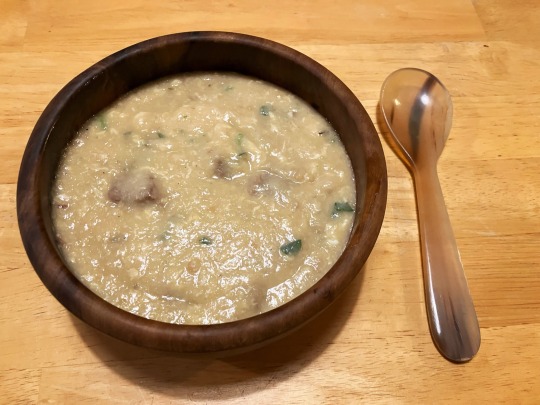
#sorry this took so long!!!#recipe#historical food#medieval history#medieval reenactment#medieval#history#cooking#food#i’ll be on my merry way now
170 notes
·
View notes
Text

[ID: A greyish brown stew presented alongside flatbread, red pepper paste, green peppers, and carrot sticks. End ID]
سماقية / Summagiyya (Gazan stew with chard, chickpea, sumac, and 'lamb')
Summagiyya (سُمَّاقِيَّة; also translitered "sumagiyya", "sumaghiyyeh" or "sumaqiyya") is one of the signature dishes of the Gaza strip, in particular Gaza City. It consists of lamb, chard, and chickpeas in a sumac-infused broth; savor and zest is added by a dagga of dill seeds, garlic, and peppers, and nutty depth by a generous drizzle of red tahina. The resulting stew is thick, earthy, and slodgily grey (due to the green chard and red sumac)—it also has the characteristic sourness of much Gazan cuisine.
Summagiyya is most often prepared during holidays, especially Eid al-Fitr; it's an excellent make-ahead dish for these occasions, since it's even better once its flavors have had time to meld and mellow overnight. It is served cold alongside fresh vegetables, and eaten by using flatbread to scoop up each bite. This recipe provides a spiced seitan recipe to replace the lamb, but you may also use any lamb or beef substitute of your choice.
Today, summagiyya is often prepared with Israeli white tahina, as decades of punitive import laws, taxes, and restrictions have enforced Palestine's status as a consumer, rather than an producer, of food products. Israeli tariffs on, and confiscations of, Palestinian goods have forced those tahina factories that survived to import sesame seeds rather than using locally grown crops, even as they export the best of their product to Israel. The dubbing of foods such as tahina and hummus as culturally "Israeli" cuisine works to hide this exploitative relationship, and cement an Israeli national identity through the subsuming and erasure of Palestinian existence. It is for this reason that Emad Moussa writes that Palestinian cuisine has a role in "protecting against a people's very extinction."
Medical Aid for Palestinians (MAP) has put out an urgent call for donations to provide medical supplies to Palestinian hospitals when supply lines reopen. Also contact your representatives in the USA, UK, and Canada.
Ingredients:
For the soup:
500g (2 large bunches) chard (شلق), diced
80g Levantine sumac berries (Rhus coriaria)
1/2 cup soaked and boiled chickpeas, mostly cooked (40g dry / scant 1/4 cup)
1/4 cup red tahina
1/2 cup (60g) all-purpose flour
1 large yellow onion
1/4 cup olive oil
1 tsp kosher salt
2 cardamom pods (optional)
2 allspice berries (optional)
More olive oil, to fry
Sumac berries can be found in the spice section of a halal grocery store. If you're unable to locate whole berries, pre-ground will do.
For the dagga:
1 1/2 Tbsp dill seeds
5 cloves garlic
1/2 green cubanelle pepper
2-3 dried red chilis (optional)
1/2 tsp black pepper
1/4 tsp cumin
Dill seeds may be found at a halal, south Asian, or speciality European grocery store. They are commonly used in Indian food and as a pickling spice. At a south Asian grocery store they may be labelled soyo, suva, shepu, or savaa.
For the lamb:
1 cup (120g) vital wheat gluten, aka gluten flour
1/2 Tbsp ground sumac
1/2 tsp ground caraway
1 tsp onion powder
1 tsp Palestinian 7-spice
1/2 tsp garlic powder
1/2 tsp sea salt
1/2 tsp ground black pepper
1/2 tsp ground cumin
1/2 tsp ground aniseed
1/2 tsp turnermic
1 tbsp olive oil
1/2 tsp soy sauce
1 tsp miso paste
2 cloves garlic, grated
2 tsp pomegranate molasses
1 Tbsp white or red tahina
About 1/2 cup vegetarian 'beef' stock from concentrate, or vegetable stock
Pomegranate molasses is simply pomegranate juice that has been reduced to a thick consistency. It may be found in the sauces section of a halal grocery store.
Instructions:
For the soup:
1. Soak dried chickpeas in cool water overnight, or in just-boiled water for an hour. Drain and re-cover with water, and boil for 30-45 minutes, until almost fully cooked. Drain and set aside.
2. Simmer sumac seeds in enough water to cover by a couple inches for about an hour, until the water is dark red. Blend the seeds and water together, then strain the mixture through a cheesecloth.
If you're using ground sumac, skip the blending step. Use a cheesecloth or very fine metal sieve (such as one intended for brewing tea) to remove the ground spice from the water.
3. Whisk the flour into the sumac-infused water.
For the lamb:
1. Combine all dry ingredients in a large mixing bowl. Add wet ingredients other than stock and stir briefly. Add enough stock to produce a soft, smooth dough.
2. Knead by hand on a clean surface, or put in a stand mixer with paddle attachment on medium-low, for about 5 minutes. You should see stringy strands begin to form in the dough.
3. Allow to rest, covered, for 5-10 minutes to encourage gluten formation. Knead for another 3 minutes. Do not over-knead.
4. Tear the dough into bite-sized pieces.
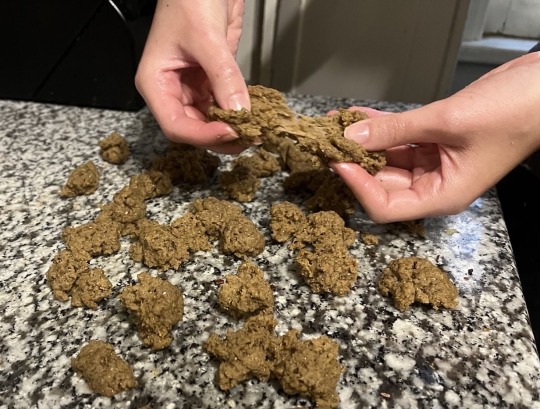
Stringy seitan being pulled apart into pieces.
You may also shape the dough into a slab and cube it with a sharp knife—the lamb or beef used in summagiyya is usually cubed—but I prefer the texture of torn seitan to sliced.
5. Steam the seitan pieces for 10 minutes in a bamboo steamer or using a metal steamer basket. Place the bamboo steamer in the bottom of a wok and cover its base by about 1/2" (1 cm), then raise the heat to boil the water; lower the heat to keep the water at a simmer. If using a steamer basket, place it over the opening of a pot containing a couple inches of water and bring it to a simmer. Start the timer when the water begins simmering.
6. Heat olive oil on medium-high and sear the steamed seitan pieces, turning as necessary, until deeply browned on all sides. Set aside.

Fried seitan pieces.
You can save a step here by searing the raw seitan, then returning it to the pot after you've fried the onions to simmer it rather than steaming. I found that this produced a mushier texture.
For the dagga (دقة):
1. Grind cumin and black pepper thoroughly in a mortar and pestle, then add dried red pepper and dill seed and crush coarsely. Add green sweet pepper and garlic and pound until a coarse mixture forms.

Dill seeds, green sweet pepper, garlic, and dried red chili on a cutting board, alongside dagga in a large granite mortar.
You may also use a spice mill or food processor.
To assemble:
1. Chop the onion. Wash the chard and slice it thinly in one direction; turn it ninety degrees and slice thinly again.
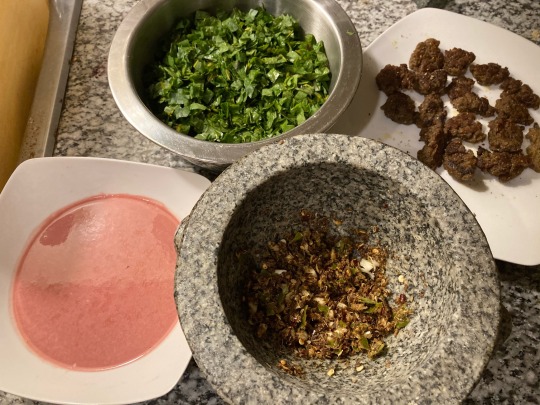
Diced chard, fried seitan, dagga, and sumac-infused water with flour.
2. In a large pot, heat a couple tablespoons of olive oil on medium. Fry chopped onion, cardamom pods, and allspice berries for a minute until fragrant. Add half of the dagga and fry until fragrant.
3. Add chard and fry, mixing often, until wilted.

Wilted chard in a wok.
4. Add sumac mixture, chickpeas, and water to cover. Bring to a boil, then lower heat to a simmer. If you didn't steam your seitan earlier, add it now.
5. Continue to stir and simmer until the stew is thick, homogenous, and greyish-brown, about 15 minutes.

Simmered stew.
6. Add the remainder of the garlic mixture, the red tahina, a pinch of ground cumin, the 1/4 cup olive oil, and salt to taste. Return the steamed and seared seitan to the pot and mix.
Serve cool with flatbread, sweet green peppers, bitter green and black olives, carrots, leafy greens, and/or pickles.
#vegetarian recipes#vegan recipe#vegan cooking#Palestinian#Gazan#chickpeas#lamb#seitan#chard#dill seeds#pomegranate molasses
501 notes
·
View notes
Text
@skyrim-forever
Here's my non-authentic leftover curry recipe
Medium sweet potato
A bit of leftover rice (if you have)
Chickpeas
Bell peppers (3/½)
Beef stock (3/1½ w/ veggie)
Veggie stock
3x garlic
Red onions (5x, 2 for base and 3 for topping)
Shallot (1x)
Pureed tomatoes (can't handle fresh ones but if you have...)
Tomato concentrate
Fresh coriander
Fresh mint
Spices: salt, ginger paste, turmeric, curry leaves, cumin, coriander seeds, mustard seeds, fenugreek powder, garam masala, dried Piri Piri, cloves, cardamom, szechuan pepper
1. Wash, slice and put bell peppers, sweet potato, garlic, 2 red onions and the shallot into a casserole. Spray with oil or add a bit of coconut fat. Put into the oven at 200° until it blackens a bit.
2. Clean and quarter champignons. Fry them at high heat in coconut fat and put them aside. Once finished, roast the leftover red onions.
3. Wash and briefly pre-boil chickpeas.
4. Prepare beef and veggie stock in a medium pot. Add leftover rice.
5. Once the oven veggies are done, put all of them except half of the sweet potato into a blender and blend. Use the broth to clean blender so as not to waste the rest of the paste to the broth.
7. Put the remaining sweet potato and the champignons aside (use leftover oven heat)
8. Put paste into a pan with the spices and tomato concentrate and roast for a short while.
9. Add everything (chickpeas, remaining veggies, paste) to the rice-broth, add pureed tomatoes and stir.
10. Add ~125 ml of yogurt, a bit of fresh coriander and a bit (1 tsp. of fresh, chopped mint). Top with the roasted red onions from earlier.
Let simmer briefly and enjoy.
I served it with the rest of yoghurt refined with line juice, fresh mint and a bit of chopped galangal.
Wish I could tell you the exact measurements but I'm too tired and too drunk so eh... Feel them in your heart; you'll cook up something good.
9 notes
·
View notes
Text
Hermit-a-Day May (Day 25)
VintageBeef - 37 days
A good meal goes a long way.
Times were difficult. More than a month ago, the Moontower had fallen, and nothing much had changed since it crashed into the ground. One building, still standing, provided shelter for the survivors. With information sparse and so few means to defend themselves, there was little to look forward to, except for a good meal.
Beef found the survivors early into the crisis. When he joined, he volunteered to be the resident cook. He had others scavenge the nearby buildings - and later, further out - for any kind of food. He had it brought to his makeshift kitchen, where he spent most of his days.
The food was decent. Beef wasn’t a master chef, but he wasn’t terrible, either. Plus, since they were in the middle of the apocalypse, any kind of decent meal would taste like a five-star experience.
A good meal goes a long way. Already after the first few servings, Beef could see a shift in demeanor. Before they had a designated cook, the survivors appeared to be more dejected and less hopeful. Not only did a good meal provide them with the energy to get through the day, it also provided them with hope. On a full stomach, everyone could concentrate better and do what they needed to do. A good meal kept people from thinking about hunger and made sure everything ran as smoothly as possible.
Food, however, wasn’t infinite. Daily, the people Beef sent out would need to go further and further. Most perishables had already perished, and though he still had a good stock of canned foods and similar items, that stock may run out. The city could only hold a finite amount of food, and they had no idea for how long they still needed to survive. They didn’t know how much food they would need before help would arrive, or before they could solve the problem.
It also didn’t solve all problems. Despite their full stomachs, Beef could see how the morale shifted. From despair to high morale boost once the engineers proposed plans for their machine, only to slowly decline over the days. Progress was slow. Nothing else could be done, except to hide away from the shadows. Despite good food, morale declined as uncertainty took hold in everyone’s mind. Smiles became more and more rare, and hope was only found in the smallest crevices.
A good meal goes a long way, and Beef tried his best to provide at least this small comfort to the survivors. Yet, if this crisis didn’t end soon, they would need to start rationing, and despair would have a chance to return.
8 notes
·
View notes
Note
Here's a step-by-step process to create a steak-flavored protein cake. This assumes you're aiming for a savory, high-protein treat that mimics the taste of steak while maintaining a cake-like texture:
Ingredients
1 cup whey protein powder (unflavored or beef-compatible flavor, e.g., neutral savory)
1/2 cup almond flour (for texture and binding)
1/4 cup oat flour or finely ground oats (adds structure)
1 tsp baking powder (for rise)
1/2 tsp salt (enhances savory flavor)
1-2 tbsp beef bouillon powder or concentrated beef stock powder (for steak flavor)
1 tsp garlic powder (complements steak taste)
1 tsp onion powder (adds depth)
1/2 tsp smoked paprika (for a grilled steak vibe)
2 large eggs (binding and moisture)
1/4 cup unsweetened almond milk or beef broth (for moisture and flavor)
2 tbsp melted butter or olive oil (richness)
Optional: 1-2 tbsp Worcestershire sauce (for umami and steak authenticity)
Optional: Finely chopped cooked steak bits (for texture and real steak flavor)
Equipment
Mixing bowl
Whisk or spoon
Measuring cups and spoons
Cake pan (small, e.g., 6-inch round or loaf pan)
Oven
Non-stick spray or parchment paper
Steps
Preheat the Oven: Set your oven to 350°F (175°C). This ensures even baking for the protein cake.
Prepare the Pan: Grease a small cake pan with non-stick spray or line it with parchment paper to prevent sticking.
Mix Dry Ingredients: In a mixing bowl, combine the protein powder, almond flour, oat flour, baking powder, salt, beef bouillon powder, garlic powder, onion powder, and smoked paprika. Whisk them together to evenly distribute the flavors and leavening agents.
Mix Wet Ingredients: In a separate bowl, whisk the eggs, almond milk (or beef broth), melted butter (or olive oil), and Worcestershire sauce (if using) until smooth. This creates the wet base that will carry the savory steak flavor.
Combine Wet and Dry: Slowly pour the wet mixture into the dry ingredients, stirring until a thick batter forms. Avoid overmixing to keep the texture light. If adding chopped steak bits, fold them in now.
Adjust Consistency: If the batter seems too thick (like dough), add a splash more almond milk or broth, 1 tablespoon at a time. It should be pourable but not runny, similar to a thick pancake batter.
Pour into Pan: Transfer the batter into the prepared cake pan, spreading it evenly with a spatula.
Bake: Place the pan in the preheated oven and bake for 20-25 minutes. Check doneness by inserting a toothpick into the center—if it comes out clean or with a few moist crumbs, it’s ready. The top should be golden and slightly firm.
Cool: Let the cake cool in the pan for 5-10 minutes, then transfer it to a wire rack to cool completely. This helps it firm up and prevents sogginess.
Slice and Serve: Once cooled, slice into portions. You can serve it warm or cold, plain or with a side like a gravy-inspired dip (e.g., beef broth thickened with a bit of protein powder or flour).
Tips
Flavor Tuning: Taste the batter before baking (since it has raw eggs, do this cautiously) and adjust seasoning if needed—more bouillon or spices for a stronger steak flavor.
Texture: For a moister cake, slightly underbake it (18-20 minutes). For a denser, bread-like result, bake fully.
Optional Topping: Brush with a mix of melted butter and Worcestershire sauce after baking for extra steak essence.
This recipe balances protein content with a savory, steak-inspired taste, making it a unique twist on a traditional protein cake! Let me know if you'd like to tweak it further.
What
9 notes
·
View notes
Text
Watching the H5N1 stuff get worse and worse--I'm hoping we have until late next year before it goes reliably human-human, but it wouldn't surprise me if it was this winter--and not being able to do much makes me anxious, so I've been composing lists of stuff to do. I keep thinking, if this were August, 2019, and I knew covid was coming, what would I prepare? If this one goes off like the scientists think it might, it'll be much worse than covid.
Right now, I'm concentrating on food. My plan is to have enough hunker down supplies by mid-September that if things go bad in the normally-scheduled October-February flu season, we'll be okay simply not leaving the house at all. There are only two of us here now, and if things go bad there may be as many as four (as I have two separate friends I'd push hard to come stay here with us), so I need to make sure we have 4 meals x howevermany days I choose. I'm building up to six months, but I'm beginning the plan at three. While a lot of Serious Prepper lists have pretty generous caloric allowances, the MFH and I eat pretty light, and we're both smaller than the average adult human, which does give us even more squeak room here.
We started out with dry staples--bread flour, AP flour, semolina, rice, beans, pasta, lentils, powdered milk--though I have still to get powdered eggs (I'll dehydrate those myself), more dry beans (I'm going to use up a lot of what we have when I do my canning run for the winter, and so far I haven't been able to get my hands on kidney beans in any decent amounts), quinoa, and one more kind of pasta. Right now we have about 2/3 of what I'd want; we'll be holding things at this level, replacing staples as we use them, and if things look more serious we'll do another big shop and give ourselves additional stock of the AP flour, the bread flour, the rice (which we already buy in 40-50 lb bags anyway, we're Asian), the dry milk.

Then there's the perishable stuff; yesterday, the MFH and I took advantage of some very nice sales and got seventy pounds of meat for two hundred and twelve dollars. Beef brisket for stew, pork butt for sweet molasses chili, ground beef for hotter chili, pork loin for white bean soup. Still have to get chicken (which was pretty much sold out at our bulk place) for chicken soup (to be pressure canned), chicken and mushroom cream soup (to be vacuum-packed and frozen).

Very very soon it'll be time to harvest my leeks and my butternut squashes, for leek and potato soup (either finished with cream, blended to a smooth-ish consistency and frozen, or *not* blended down, and just socked away in pressure-canned Ball jars without the cream added; will it take me longer to thaw it, or to take my immersion blender to the hot individual meals later on?) and canned butternut for baking with or making soup or chili or making pasta sauce.
I might can a bunch of just potatoes, too, to keep 'em shelf stable (plus that front-loads a lot of the work of producing a meal later).


So I need to buy onions and carrots and potatoes and celery and garlic and mushrooms and corn, cream, red wine, tomato paste (because my vines got blight this year, sigh--I've managed to can one single run of tomato sauce and that's IT), ten dozen fresh eggs to dehydrate and powder and store in the fridge in case of egg shortages, several pounds of beans to be thrown into the chilis and...hm...fifteen pounds more, twenty pounds more, to have on hand? And then for non-canning purposes we'll need butter, oil, white vinegar (I've used a lot of it for pickles this year), various Asian food staples like black and rice vinegars, oyster sauce, black mushrooms and so on. As for pre-made, mass-produced foods, I'll probably make another post about them later.
While this is more than I'd generally stock in a single season, I do generally put about 100 quarts of home-canned food by a year, and I never keep less than 75-100lb of flour on hand anyway because of how frequently I make bread. So though it sounds like a lot up front, it's not hoarder level; everything I stock will be eaten, some of it pretty much immediately (the beef stew is so good). And putting it all by now means that we'll be less of a burden on our community safety net, if push comes to shove. When the covid pandemic hit I had dozens of jars of food on the shelf already, which gave me a little peace when things were looking scary. We were able to share some of our stores with people who hadn't had the great privilege of long afternoons spent seeing to the personal stores. That's a better option, to my mind, than needing to panic-shop right as things start getting a little wild.
Basically, if things go bad, we'll have food for a while. And if things don't go bad, we'll have food for a while. It's win-win. And it keeps the floor under my feet when I'm feeling unsteady, to be able to sneak down into the cool, still basement and look at row on row of gently gleaming jars of food security.
#real world prepping#still not time to freak out#this is not cottagecore#my actual life#magical flying husband#h5n1#h5n1 prep
15 notes
·
View notes
Text


because meatloaf, that’s why




***ingredients: 1 onion, 1 teaspoon of garlic powder, 2 tablespoons of mayonnaise, 12 ounces of potatoes, 1 ounce creamy horseradish sauce, 1/4 cup panko breadcrumbs, 2 teaspoons of Dijon mustard, 1 packet of chicken stock concentrate, 4 slices of sourdough bread, and 10 ounces of ground beef
#meat loaf#meatloaf sandwich#roasted vegetables#roasted potatoes#fresh veggies#fresh vegetables#veggies#vegetables#amateur cooking#hello fresh#mine
2 notes
·
View notes
Text
Onion free tacos
Ok, it took a while but I think I finally made a decent beef taco (+seasoning) recipe without onion! A few folks asked for an update when i figured it out so here you go, It doesn't taste exactly like the store bought (old el passo) stuff, but i still think it's really good!
For 1kg of beef taco mince, i added:
Black pepper
Oregano
Smoked paprika
Minced garlic
Minced ginger (this really helped make up for the savoury flavour that you loose when you take out the onion)
Garlic/herb salt
Coriander (cilantro)
Siracha sauce (add little bits at a time, or it becomes overwhelming. If you dont like spice, only add a very small amount)
Beef stock (be careful to check the stock has no onion, most do but the brand "Massel" in Australia is safe)
Ketchup (NOT TOMATO SAUCE as tomato sauce has onion in it and tends to be sweater than ketchup - though that might vary depending on where you are - e.g. american ketchup is WAY sweeter than what we have in Australia. for Australians, Heinz tomato ketchup is safe. You can also use tomato paste concentrate for something more neutral, just make sure to add more beef stock if you do)
Chili flakes - i used hot flakes, but they come in medium and mild too if you're not into spice
Kidney beans
Cook the mince in a frying pan and add the seasoning/sauces/beans while cooking. Once done, serve with cheese, sour cream, any salad you like (my partner adds cherry tomatos and lettuce) and either siracha sauce or ketchup (most of the hot sauces and taco sauces have onion in them too). If you're making soft tacos/buritos, I also recommend getting all the meat out of the pan and frying the whole taco in it to melt everything together using the leftover juices/oils! The only downside of this recipe is that it is very oily, so be prepared for that lol.
I kind of just threw everything in the pan until it started smelling good so I don't have exact measurements, but I can update with those once I've made these a few more times.
Also, for folks who are allergic to garlic and onion, I found this recipe. I personally didn't like it, but my support worker (who is allergic to both) made it, and she said she enjoyed it. It does have spring onions in it, but you can take them out, and it doesn't seem to change much if they're an issue for you.
8 notes
·
View notes
Text
i made beef burgundy bourgunion bourgeoisie Anyways it’s came out really yummy and with mashed potatoes that i fucked up for a second but then it turned out it was really good as a potato soup and then using the beef as like concentrated and anyways now i can’t stop farting btw
oh and when i reheat the potato’s it becomes more like potato’s and i think the beef would go well w more stock like i could freeze it ? into cubes .. but how ..
4 notes
·
View notes
Text
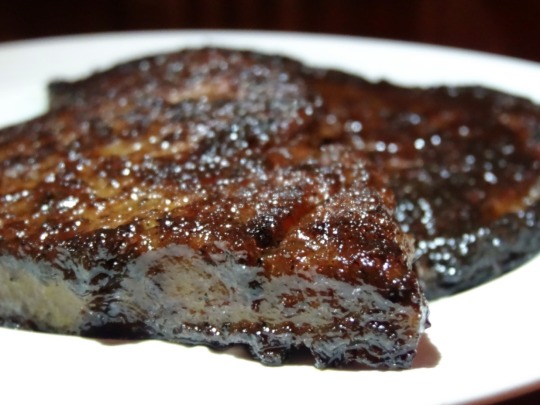
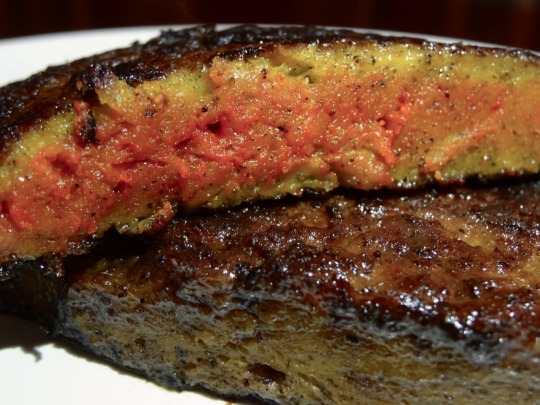
[ID: First image is of two dark brown glazed lamb chops. Second image is a close-up; one of the chops has been cup open to show a pink interior. End ID]
Seitan lamb chops
This vegan meat can be used as a substitute for lamb chops or rack of lamb. Like well-cooked lamb, it is fine-grained, moist, subtly sweet, and meltingly tender. Once simmered it is ready to be seared, breaded, fried, or sliced, and included in your favorite recipes.
The seitan is made using the washed flour method, which kneads dough in water to separate the gluten from the starch: this allows you to control how much starch you leave alongside the gluten in the dough, and thus how tender versus chewy your final cut of meat will be. This recipe makes a dough that leaves more starch in than most seitan recipes do, and then kneads the dough again to distribute that starch into an even, fine grain. A simmer in a spiced, aromatic broth leaves the final product tender, moist, and flavorful all the way through; the broth is then cooked down to a glaze.
The spices called for in this recipe are geared towards replacing lamb in Palestinian recipes, but they can easily be swapped out to complement the flavor profiles of other dishes.
Recipe under the cut!
Patreon | Tip jar
Makes 4 large lamb chops.
Ingredients:
For the dough:
720g bread flour (or any white wheat flour with at least 12% gluten)
About 2 1/4 cups water
For the dry flavoring mix (scaled to 455g dough yield):
2 tsp (7.5g) ground sumac
1 3/4 tsp (5.25g) onion powder
1 tsp (4g) kosher salt (1/2 tsp table salt)
1 tsp (5.5g) vegetarian granulated sugar
1 tsp (2.5g) black peppercorns, toasted and ground
3/4 tsp (2g) caraway seeds, toasted and ground
3/4 tsp (3g) garlic powder
3/4 tsp (2.5g) ground turmeric
3/4 tsp (2g) cumin seeds, toasted and ground
3/4 tsp (1.5g) aniseed, toasted and ground
1/2 tsp beet powder; or 5 drops red + 1 drop green food coloring
1/2 tsp (2.5g) MSG (optional)
To fry:
4 tsp vegan margarine or ghee (سمنة), divided
4 tsp olive oil, divided
For the simmering broth:
2 Tbsp soy sauce (I used Chinese aged soy sauce)
1 Tbsp red tahina
2 tsp miso paste (preferably red)
2 tsp pomegranate molasses
2 tsp vegetarian 'beef' stock concentrate (optional)
1 small yellow onion, quartered
2 cloves garlic, crushed
1 bay laurel leaf
1 stick cinnamon bark
5 allspice berries
5 green cardamom pods, crushed
2 cloves
1/2 tsp black peppercorns
1 tsp vegetarian granulated sugar
Several cups water
Instructions:
To wash the flour:
To make seitan using the washed flour method, a dough is first made out of flour and water; then, the dough is washed in water multiple times. The water carries off the starch, leaving the gluten behind.
1. Make the dough. Mix flour and water in a large mixing bowl until dough comes together. Knead for several minutes, and then cover the dough and allow it to rest for another 10-15 minutes to develop gluten. After resting, the dough should be very smooth, elastic, and stretchy.
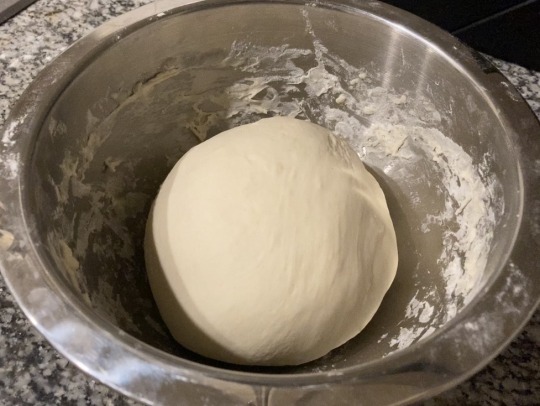
2. Soak the dough. Fill the bowl with enough cool water to cover the dough, and let it soak for about an hour. This allows gluten to continue developing.

3. First wash. Leave the soaking water in the bowl, and begin to knead the dough with your hands under the water. Repeatedly pull, stretch, fold, and press the dough for several minutes to knead, occasionally using your fingertips to break through and shred or mangle the dough as you pull. Soon, the water should be a thick, opaque white.
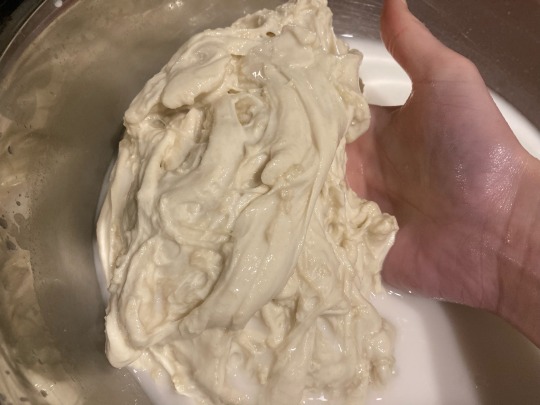
4. Drain the dough. Set up a colander over a very large container, and pour the contents of your mixing bowl through. You can also just pour the starchy water down the sink if you don't have plans to use it (to make liangpi noodles, or dumpling wrappers, or any of the recipes out there for vegan bacon using wheat starch...).
At this point, you will see two distinct substances in the dough: the gluten, which is thin and stringy and feels rubbery when pinched, and the starch, which is thick and 'globby' and feels soft when pinched, offering no resistance. We want to wash the flour a few times until most of the starch has been removed, and there are only some small globules interspersed throughout the stringy gluten.
5. Second wash. Return the dough to your mixing bowl and fill it with fresh cool water. Knead and pull the dough for another few minutes, until the water once more turns opaque. There should be fewer large areas of starch in the dough, and more development of the gluten strands. Drain the dough again (just like in step 4).
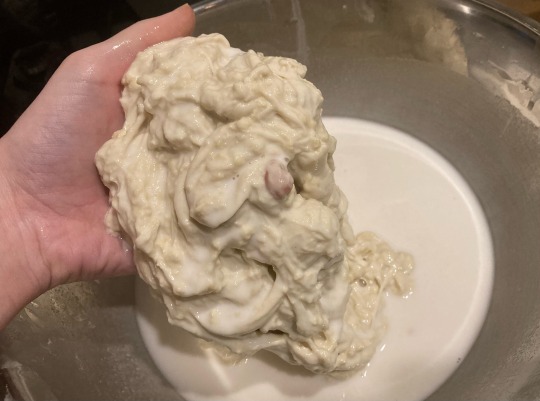
6. Third and fourth wash. Repeat this process another time or two, until the starch globules are about 20% of what you see, and the gluten is around 80%. For the last wash, the water should be a bit less opaque with starch than it was for the first one, but it should be more than a bit cloudy. You should see your fingers when you cup some of the water in your hand, but not the bottom of the bowl.

After the third wash


After the fourth wash
7. Drain the dough. Drain the seitan again and allow it to continue draining, flipping over once, until it is noticeably less wet. Squeeze the dough to remove any extra water or starch on the surface.
You now have your washed flour! This will be the base for the rest of the recipe. I had 455g of dough at this point.
To finish the dough:
1. Add all dry ingredients to the dough and knead again to distribute evenly; or use a blender for about 30 seconds until everything is well-incorporated and the gluten strands are visible.
2. Pull the dough into a single long, thick strand, and then tie it into a couple knots. Do this a few times to build structure.
To cook:
The dough will first be seared to develop a crust, then simmered to infuse it with more flavor. After a rest in the simmering liquid, it is seared again to re-crisp, then tossed in the thickened liquid to form a glaze.
1. Divide dough into four pieces. In a large skillet, heat 2 tsp of margarine and 2 tsp of olive oil (or use all olive oil). Add dough pieces and push flat with a spatula. Fry, turning as needed and intermittently pressing flat with the spatula, until the surface is browned and crispy.

2. Mix liquid simmering ingredients together and whisk to combine. Pour over browned chops and add whole spices and aromatics. If necessary, add more water to cover.
3. Slowly bring simmering liquid up to a bare simmer. Don't let it come to a rolling boil, which could produce a spongey texture.
4. Cook at a very low simmer, uncovered, for 20 minutes, stirring occasionally. Remove from heat and allow to soak in the simmering liquid (including spices and aromatics) for at least an hour in the fridge, or overnight.
This is a good place to stop for the night if you want to make these ahead of time.
5. Remove lamb chops from liquid. In a large pot or deep skillet, bring simmering liquid (including spices and aromatics) to a boil, uncovered, until considerably reduced.
6. Strain to remove whole spices and aromatics. Return to pan and continue to reduce until thickened to a glaze-like consistency.
7. In a clean skillet, fry lamb chops again in remaining margarine and oil until browned and crispy. Add glaze and cook, flipping and agitating occasionally, for a couple minutes until coated.
Serve immediately over rice or frika (فريكة / freekeh), topped with fried pine nuts, alongside plain cultured soy yoghurt, pickles, olives, and a side salad, etc.
153 notes
·
View notes
Note
About that Hanukkah tag post, I mean my generation is justifying Osama bin Laden and say America needs to be burn to the ground due to slavery and such.
Hmm, yet Muslim and Latin Americans countries are a okay. Oh right right the left only know about the USA/UK meddling and not you know the corruption that the USA/uk took advantage of.
Okay they wouldn’t get nuance about the Palestine-Israel conflict. These fuckers were raised on tv and not by parents
Tangent, I think I understand what working class boomers feels after the summer of love. Being part of a generation who upper middle class brats are so out of touch yet you realize they will have more power than you in your lifetime.
Hanukkah tag post just proves that there's people that no how much they deny it, they absolutely hate Jewish people, only reason to do that at all, since while the largest single concentration of them is in Israel for sure there's a equal number of Jewish folks spread across the globe, spamming their tag is only showing that it's not about Israel for the people doing it.
If you've got a legitimate beef with Israel, you're going to know better than to spam the tag.
as for the bin laden thing, another post last night
People on here cheering for that ship that got taken by yemeni pirates without a single ounce of knowledge about what else is going on in that corner of the world is the one that really bugged me.
that's going to accelerate the deaths of thousands through treatable diseases and starvation because of rerouted shipping, not like the guy from Israel even owned the boat just stock in it anyhow
It could be funny if it weren't for the massive humanitarian disaster that's already there, oh and I thought after all those protests because of that woman who the "morality police" killed that we weren't going to be cheering on iran for much of anything.
but hey it's ok to ignore a misogynistic oppressive regime that delights in destabilizing the entire region if we can stick it to those pesky jooz right guys.
with the boomer parents, there's all kinds of them the mythology seems to have leaked out to the point that folks think it's the straight up truth
11 notes
·
View notes
Text

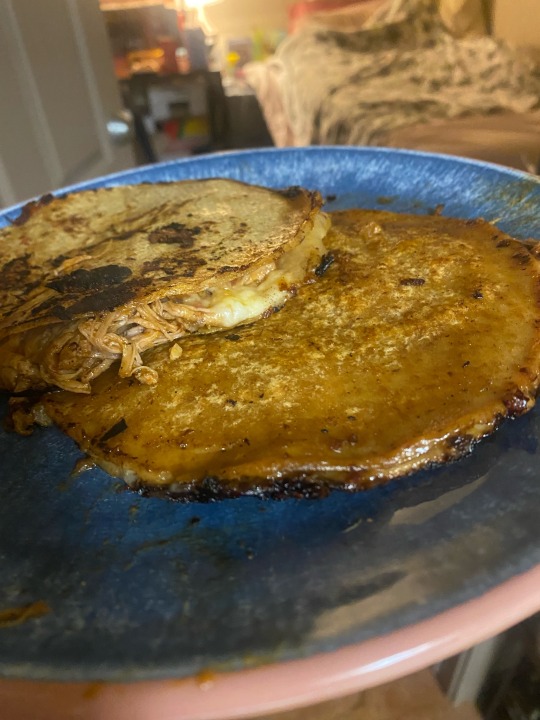
shitty pics but I had two small pork tenderloins in my freezer, and I was kinda tired of roasting them or making stew. So I cut it into rather large chunks, and I seared them in my dutch oven with a seasoning blend of cumin, chili powder, red pepper flake, etc. while they browned I sautéed some onions and garlic in my instant pot with bay leaves and a cinnamon stick, adding tomato paste and chili crunch (I needed something spicy and concentrated!) when it became fragrant. I added the pork to this and deglazed with beer, topping with a glug of beef stock and adding lime and orange juice. I let that shit pressure cook for an hour and it came out AMAZING.
then I made quesadillas and topped them with cotija cheese and I’m very very happy. I’m using the leftovers for nachos and ramen this week!!!!
10 notes
·
View notes
Text
One-pot bolognese by Taff
I have been kind of... away from social media for a while, so have a recipe in my absence.
What you need:
A single tall pan (so, a pan that is deep, goes up!) with a lid. Either wide enough to fit whole spaget, or you gotta CRACK
One (1) onion
250 gr of ground beef (can substitute with beef/pork mix or maybe even turkey or chicken I am sure). Except today Taff went nuts and added 500gr cause she loves her meat mmm mmhmm. nom.
Two (2) garlic toes. Or as Taff says: INFINITE. They are meant to be pressed, but I usually just chop them, I like the chunks.
125 gr of spaghetti. Mine are supposedly done after 9 minutes, so that may be important.
One (1) cube of beef stock. They are like these dried stock cubes, come in 11gr per cube here.
A packet (400 gr) of tomato sauce of your choice. Preferably a taste you really like, since this is a quick cook so a lot of the flavour ocmes for it. Taff, as she realised her tomato sauce is just tomato with MORE garlic: *mwahaha*
Recipe says: Ketchup, one dinner spoon full. Taff says: Concentrated tomato puree. A LARGE SQUIRT
Recipe says: Chili flakes, half a tea spoon. Taff says: Cayenne pepper, OH MY GOD NOT THAT MUCH, TAFF (half a tea-spoon is enough, don't be me)
3 and a half DL of water (that's deciliter, not Dying Light - so 350 ml)
How you do it:
Chop up the onions (don't cry don't cry don't cry, oh no, I'm crying) and press or chop the garlic
Put on pan, add some oil (I use olive oil) and fry the onions for like two minutes until softish (don't cry, don't cry, don't- oh god we are doing it again)
Add garlic and meat, fry for another 3 minutes until meat has some colour
Add the water and the tomato sauce, plus the beef stock and the chili flakes cayenne pepper. Squirt in ketchup tomato puree.
Stir
Throw in the spagets
Stir
Put on lid and let cook for 12 minutes (that is more than the 9 the spagets usually need)
STIR sometimes so the spagets don't get burnt at the bottom
Eat (put some Parmesan over if you have it)
7 notes
·
View notes
Text
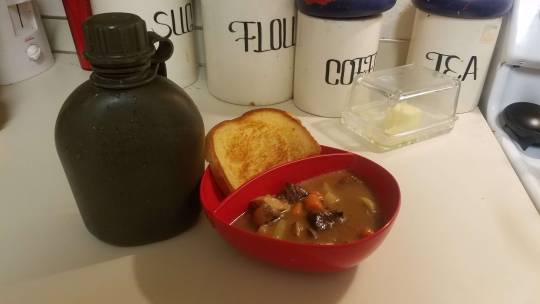
Picture for street cred. Here's something that actually deserves to be in the cooking tag unlike the ribs I made earlier lol.
I've been collecting drippings every time I roast a pack of chicken. I ended up with roughly a quart after removing the fat. I simmered the stock to further condense it down to about a pint to concentrate the gelatin for a richer broth and added some drippings from the ribs I made for lunch.
I cut up almost 2lbs of chuck steaks into bite sized pieces then seared it in the soup pot. I added a minced onion, some garlic, some bay leaves, the chicken stock, and about a pint of beer. I brought the mix to a boil then let it simmer for an hour.
After an hour I chopped up 4 medium russets and a couple hands full of baby carrots and dumped them in the pot. Half an hour later I dumped in a couple hands full of chopped celery and let it go another 15 minutes.
To finish it off I scooped out some broth, mixed in some corn starch into a slurry, and reintroduced it to the pot until it thickened to where I wanted it.
And to top it off a slice of toast fried on the skillet because it's superior to using a toaster.
@theminingengineer want to trade a bowl for your beef barley stew?
8 notes
·
View notes